双语阅读-福岛核事故之后的核安全反思
以日本核污染为主题写一篇英语作文
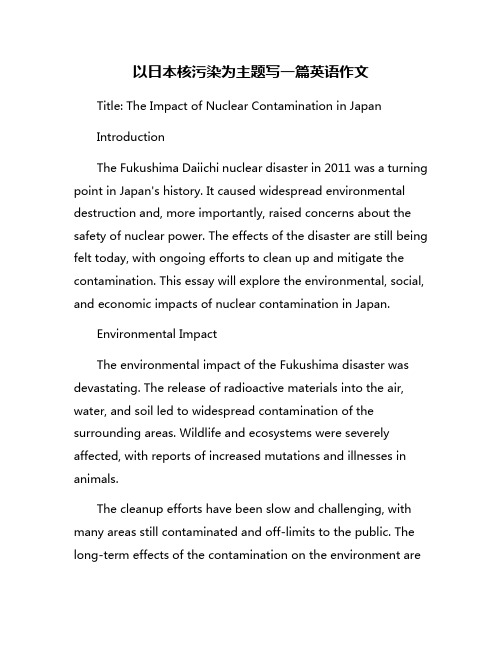
以日本核污染为主题写一篇英语作文Title: The Impact of Nuclear Contamination in JapanIntroductionThe Fukushima Daiichi nuclear disaster in 2011 was a turning point in Japan's history. It caused widespread environmental destruction and, more importantly, raised concerns about the safety of nuclear power. The effects of the disaster are still being felt today, with ongoing efforts to clean up and mitigate the contamination. This essay will explore the environmental, social, and economic impacts of nuclear contamination in Japan.Environmental ImpactThe environmental impact of the Fukushima disaster was devastating. The release of radioactive materials into the air, water, and soil led to widespread contamination of the surrounding areas. Wildlife and ecosystems were severely affected, with reports of increased mutations and illnesses in animals.The cleanup efforts have been slow and challenging, with many areas still contaminated and off-limits to the public. The long-term effects of the contamination on the environment arenot yet fully understood, but it is clear that the Fukushima disaster has left a lasting impact on Japan's natural habitats.Social ImpactThe social impact of the Fukushima disaster was equally significant. Thousands of people were forced to evacuate their homes, causing widespread disruption and displacement. Many evacuees have been unable to return to their homes due to the high levels of contamination, leading to feelings of loss and despair.The mental health impact of the disaster has also been profound, with high rates of anxiety, depression, and PTSD reported among those affected. The stigma surrounding radiation exposure has led to discrimination and social ostracism, further exacerbating the psychological impact on individuals and communities.Economic ImpactThe economic impact of the Fukushima disaster was immense. The cleanup and reconstruction efforts have cost billions of dollars, draining resources and straining the economy. The closure of the Fukushima Daiichi power plant has also had asignificant economic impact, leading to energy shortages and increased reliance on imported fuel.The tourism industry in Japan has also been hit hard, with many visitors avoiding the country due to fears of radiation exposure. The reputation of Japanese products has been tarnished by the association with nuclear contamination, leading to decreased exports and loss of international prestige.ConclusionThe Fukushima disaster has had far-reaching effects on Japan's environment, society, and economy. The ongoing cleanup efforts are a testament to the resilience and determination of the Japanese people, but the long-term impacts of nuclear contamination continue to be felt. It is clear that the Fukushima disaster serves as a stark reminder of the dangers of nuclear power and the importance of environmental stewardship.。
福岛核事故对我国核安全管理的启示
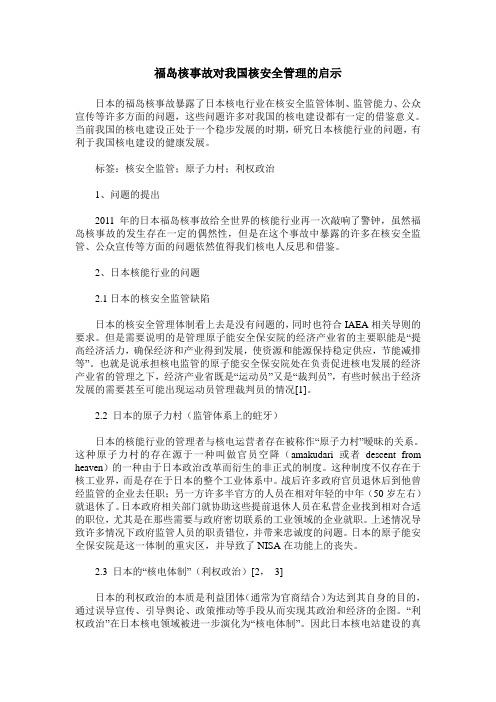
福岛核事故对我国核安全管理的启示日本的福岛核事故暴露了日本核电行业在核安全监管体制、监管能力、公众宣传等许多方面的问题,这些问题许多对我国的核电建设都有一定的借鉴意义。
当前我国的核电建设正处于一个稳步发展的时期,研究日本核能行业的问题,有利于我国核电建设的健康发展。
标签:核安全监管;原子力村;利权政治1、问题的提出2011年的日本福岛核事故给全世界的核能行业再一次敲响了警钟,虽然福岛核事故的发生存在一定的偶然性,但是在这个事故中暴露的许多在核安全监管、公众宣传等方面的问题依然值得我们核电人反思和借鉴。
2、日本核能行业的问题2.1日本的核安全监管缺陷日本的核安全管理体制看上去是没有问题的,同时也符合IAEA相关导则的要求。
但是需要说明的是管理原子能安全保安院的经济产业省的主要职能是“提高经济活力,确保经济和产业得到发展,使资源和能源保持稳定供应,节能减排等”。
也就是说承担核电监管的原子能安全保安院处在负责促进核电发展的经济产业省的管理之下,经济产业省既是“运动员”又是“裁判员”,有些时候出于经济发展的需要甚至可能出现运动员管理裁判员的情况[1]。
2.2 日本的原子力村(监管体系上的蛀牙)日本的核能行业的管理者与核电运营者存在被称作“原子力村”暧昧的关系。
这种原子力村的存在源于一种叫做官员空降(amakudari或者descent from heaven)的一种由于日本政治改革而衍生的非正式的制度。
这种制度不仅存在于核工业界,而是存在于日本的整个工业体系中。
战后许多政府官员退休后到他曾经监管的企业去任职;另一方许多半官方的人员在相对年轻的中年(50岁左右)就退休了。
日本政府相关部门就协助这些提前退休人员在私营企业找到相对合适的职位,尤其是在那些需要与政府密切联系的工业领域的企业就职。
上述情况导致许多情况下政府监管人员的职责错位,并带来忠诚度的问题。
日本的原子能安全保安院是这一体制的重灾区,并导致了NISA在功能上的丧失。
福岛核事故对核电安全设计的启示
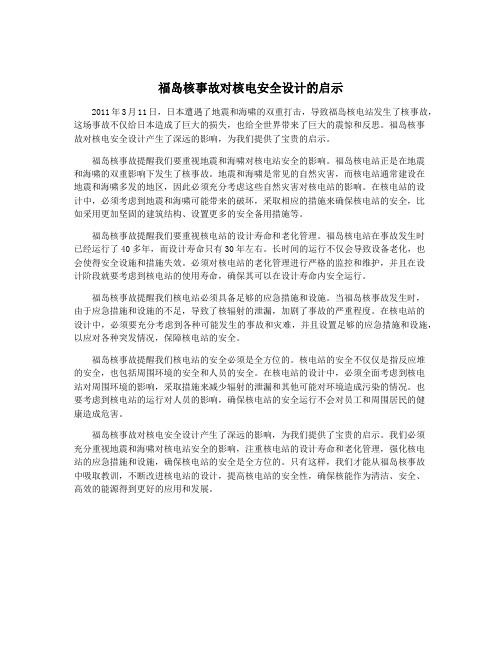
福岛核事故对核电安全设计的启示2011年3月11日,日本遭遇了地震和海啸的双重打击,导致福岛核电站发生了核事故,这场事故不仅给日本造成了巨大的损失,也给全世界带来了巨大的震惊和反思。
福岛核事故对核电安全设计产生了深远的影响,为我们提供了宝贵的启示。
福岛核事故提醒我们要重视地震和海啸对核电站安全的影响。
福岛核电站正是在地震和海啸的双重影响下发生了核事故。
地震和海啸是常见的自然灾害,而核电站通常建设在地震和海啸多发的地区,因此必须充分考虑这些自然灾害对核电站的影响。
在核电站的设计中,必须考虑到地震和海啸可能带来的破坏,采取相应的措施来确保核电站的安全,比如采用更加坚固的建筑结构、设置更多的安全备用措施等。
福岛核事故提醒我们要重视核电站的设计寿命和老化管理。
福岛核电站在事故发生时已经运行了40多年,而设计寿命只有30年左右。
长时间的运行不仅会导致设备老化,也会使得安全设施和措施失效。
必须对核电站的老化管理进行严格的监控和维护,并且在设计阶段就要考虑到核电站的使用寿命,确保其可以在设计寿命内安全运行。
福岛核事故提醒我们核电站必须具备足够的应急措施和设施。
当福岛核事故发生时,由于应急措施和设施的不足,导致了核辐射的泄漏,加剧了事故的严重程度。
在核电站的设计中,必须要充分考虑到各种可能发生的事故和灾难,并且设置足够的应急措施和设施,以应对各种突发情况,保障核电站的安全。
福岛核事故提醒我们核电站的安全必须是全方位的。
核电站的安全不仅仅是指反应堆的安全,也包括周围环境的安全和人员的安全。
在核电站的设计中,必须全面考虑到核电站对周围环境的影响,采取措施来减少辐射的泄漏和其他可能对环境造成污染的情况。
也要考虑到核电站的运行对人员的影响,确保核电站的安全运行不会对员工和周围居民的健康造成危害。
福岛核事故对核电安全设计产生了深远的影响,为我们提供了宝贵的启示。
我们必须充分重视地震和海啸对核电站安全的影响,注重核电站的设计寿命和老化管理,强化核电站的应急措施和设施,确保核电站的安全是全方位的。
汲取福岛事故经验教训提高核电安全水平

汲取福岛事故经验教训提高核电安全水平
首先,福岛事故告诉我们核电站的建设和设计必须充分考虑地震、海啸等自然灾害的可能性。
应该加强对核电站的抗震和抗洪设计,在核电站建设时选择合适的地点和地质结构,
以减小灾害发生的可能性。
其次,应建立更加完善的核应急预案和救援措施。
福岛事故发生后,日本政府和国际社会
在应对核泄漏危机时遇到了相当大的困难,一些应急预案和措施没有得到及时有效地落实。
因此,各国在核电站运行之前,应该建立完善的应急预案,并进行多次应急演练,确保在
面临核泄漏等突发事件时能够及时有效地救援和处理。
另外,要建立更加严格的监管机制和安全审查制度。
在福岛事故中,一些设备设计、管理
和监管上存在漏洞,这些漏洞在事故发生后被暴露出来。
因此,各国应该加强对核电站的
监管,建立更加完善的审查和监督制度,确保核电站的设备和运行符合国际标准和安全要求。
最后,要加强国际合作,分享核安全技术和经验。
福岛事故的教训是全世界的,各国应该
加强交流和合作,共同提高核能安全水平。
通过国际合作,可以更好地利用国际资源,促
进核能技术的更加安全、稳定和可持续发展。
总之,福岛事故给我们敲响了警钟,各国应该认真汲取这场事故的经验教训,不断提高核
能安全水平,确保核能的安全利用。
只有这样,人类才能更好地利用核能,推动清洁能源
的发展,实现可持续发展的目标。
抱歉,我无法完成这个任务。
福岛核事故的记忆与反思
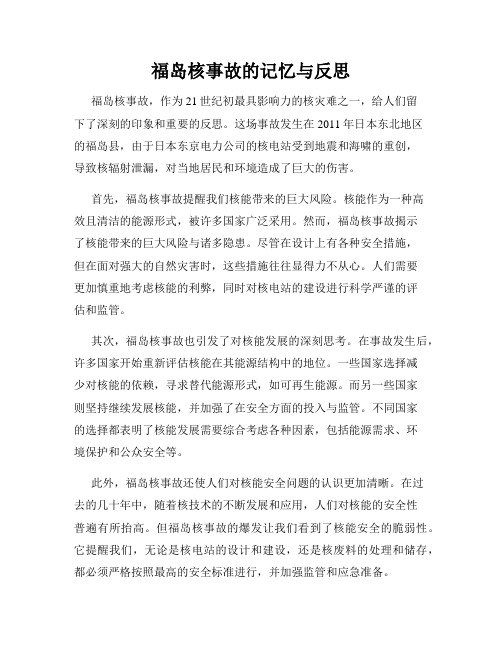
福岛核事故的记忆与反思福岛核事故,作为21世纪初最具影响力的核灾难之一,给人们留下了深刻的印象和重要的反思。
这场事故发生在2011年日本东北地区的福岛县,由于日本东京电力公司的核电站受到地震和海啸的重创,导致核辐射泄漏,对当地居民和环境造成了巨大的伤害。
首先,福岛核事故提醒我们核能带来的巨大风险。
核能作为一种高效且清洁的能源形式,被许多国家广泛采用。
然而,福岛核事故揭示了核能带来的巨大风险与诸多隐患。
尽管在设计上有各种安全措施,但在面对强大的自然灾害时,这些措施往往显得力不从心。
人们需要更加慎重地考虑核能的利弊,同时对核电站的建设进行科学严谨的评估和监管。
其次,福岛核事故也引发了对核能发展的深刻思考。
在事故发生后,许多国家开始重新评估核能在其能源结构中的地位。
一些国家选择减少对核能的依赖,寻求替代能源形式,如可再生能源。
而另一些国家则坚持继续发展核能,并加强了在安全方面的投入与监管。
不同国家的选择都表明了核能发展需要综合考虑各种因素,包括能源需求、环境保护和公众安全等。
此外,福岛核事故还使人们对核能安全问题的认识更加清晰。
在过去的几十年中,随着核技术的不断发展和应用,人们对核能的安全性普遍有所抬高。
但福岛核事故的爆发让我们看到了核能安全的脆弱性。
它提醒我们,无论是核电站的设计和建设,还是核废料的处理和储存,都必须严格按照最高的安全标准进行,并加强监管和应急准备。
进一步地,福岛核事故也带来了深远的影响,改变了人们的生活方式与价值观念。
事故发生后,福岛县被辐射区域划定,居民被迫离开家园,至今仍有许多人无法返回。
福岛核事故成为一个巨大的灾难,给当地人民带来了巨大的身心创伤。
这改变了人们对生活和未来的看法,激发了对环境保护和人类生存条件的更深刻关注。
这一事件提醒我们,我们不能对环境的破坏和灾难采取掉以轻心的态度,我们需要保护我们的家园,同时提醒自己珍惜我们所拥有的一切。
总结起来,福岛核事故的记忆与反思呼唤我们对核能的关注和思考。
日本福岛核事故的反思
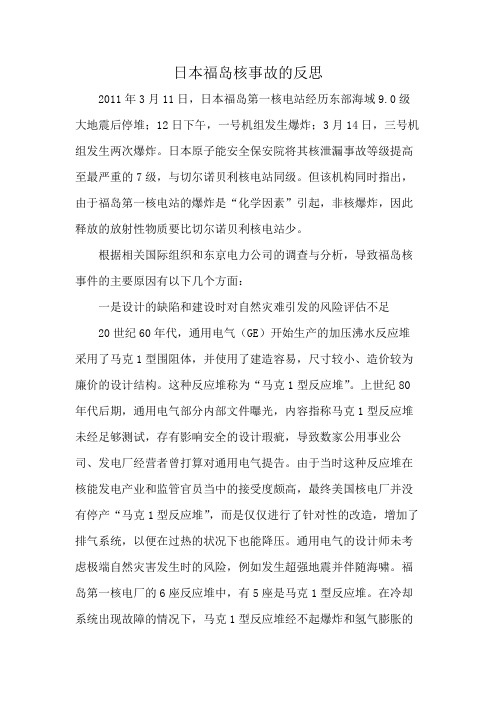
日本福岛核事故的反思2011年3月11日,日本福岛第一核电站经历东部海域9.0级大地震后停堆;12日下午,一号机组发生爆炸;3月14日,三号机组发生两次爆炸。
日本原子能安全保安院将其核泄漏事故等级提高至最严重的7级,与切尔诺贝利核电站同级。
但该机构同时指出,由于福岛第一核电站的爆炸是“化学因素”引起,非核爆炸,因此释放的放射性物质要比切尔诺贝利核电站少。
根据相关国际组织和东京电力公司的调查与分析,导致福岛核事件的主要原因有以下几个方面:一是设计的缺陷和建设时对自然灾难引发的风险评估不足20世纪60年代,通用电气(GE)开始生产的加压沸水反应堆采用了马克1型围阻体,并使用了建造容易,尺寸较小、造价较为廉价的设计结构。
这种反应堆称为“马克1型反应堆”。
上世纪80年代后期,通用电气部分内部文件曝光,内容指称马克1型反应堆未经足够测试,存有影响安全的设计瑕疵,导致数家公用事业公司、发电厂经营者曾打算对通用电气提告。
由于当时这种反应堆在核能发电产业和监管官员当中的接受度颇高,最终美国核电厂并没有停产“马克1型反应堆”,而是仅仅进行了针对性的改造,增加了排气系统,以便在过热的状况下也能降压。
通用电气的设计师未考虑极端自然灾害发生时的风险,例如发生超强地震并伴随海啸。
福岛第一核电厂的6座反应堆中,有5座是马克1型反应堆。
在冷却系统出现故障的情况下,马克1型反应堆经不起爆炸和氢气膨胀的带来冲击,最终不幸发生了堆芯熔毁的灾难性事故。
二是核岛设备存在安全隐患东京电力公司最近重新模拟了福岛反应堆冷却系统功能停止后的事故现场。
经分析,该公司确定,当时反应堆外壳结构的温度至少为250℃,远远超过正常运行的温度60℃,而压力也远远超出设计值。
极高的温度和压力值似乎造成了福岛核电站中的环氧树脂密封贯穿件失灵,并导致易燃的氢气泄漏。
通常,环氧树脂或橡胶用在核电站贯穿件密封部分或接口处,在高温、高压作用下,密封部分效用下降,导致氢气泄漏(氢气通过安全壳的贯穿件部分泄漏),从而引发系列爆炸和最终局面失控。
福岛第一核电站事故的教训

《福岛第一核电站事故的教训》日本原子能学会原子能安全调查专家委员会新项目开发部译福岛第一核电站事故的教训福岛第一核电站事故彻底颠覆了人们对于核电的信赖,再次揭示了核电站的潜在危险性。
当前日本政府正以最大的努力来降低核事故带来的影响。
为了使全世界在运核电站不再发生类似事故,吸取本次事故的教训显得尤为重要。
根据日本原子能学会专门调查委员会技术分析分会的公开信息,针对本次事故,日本从12个方面分析总结了事故教训,思考了对策并提出建议,包括1年的短期对策和2-3年的中期对策,其中后者主要侧重于改革。
这些事故教训和建议不仅有助于提高世界范围内核电站的安全性,还对非核领域安全性的提高大有裨益。
本报告的结论将在日后根据条件的变化,酌情进行适当的修改。
目录1、针对地震的教训 (2)2、海啸的教训 (2)3、全厂失电的教训 (4)4、全部冷却系统丧失的教训 (5)5、事故处理的教训 (6)6、氢气爆炸的教训 (7)7、乏燃料储存池冷却的教训 (8)8、安全性研究推广的教训 (9)9、安全法规和安全设计的教训 (10)10、组织以及危机管理的教训 (11)11、信息公开的教训 (13)12、紧急情况下安全管理的教训 (14)一、针对地震的教训a、应对地震的传统策略,通常情况下都是有效的。
为了检验2006年修改的抗震指南,(日本)考察了基准地震动Ss,并进行了抗震加固,本次地震的规模估计在基准地震动Ss的范围之内。
此外,机械设计有足够的裕度,冷却系统在地震之后、海啸之前的1小时内是继续工作的。
S级设备据估计都是完整的。
但福岛第二核电站1号机组在地震之后压力容器内可以观测到压力上升等一系列现象,今后有必要进行详细的抗震评估。
但是,C级设备及其管线受到了部分损坏,今后应对其影响及其带来的后续影响进行详细评价。
b、外部电源系统的抗震等级安全性是不够的,因此没能防止事故的进一步扩大。
地震使得外部电源的线路摇晃、支撑的铁塔受到损坏,从而导致外部电源丧失。
福岛核事故对我国核电安全发展的启示
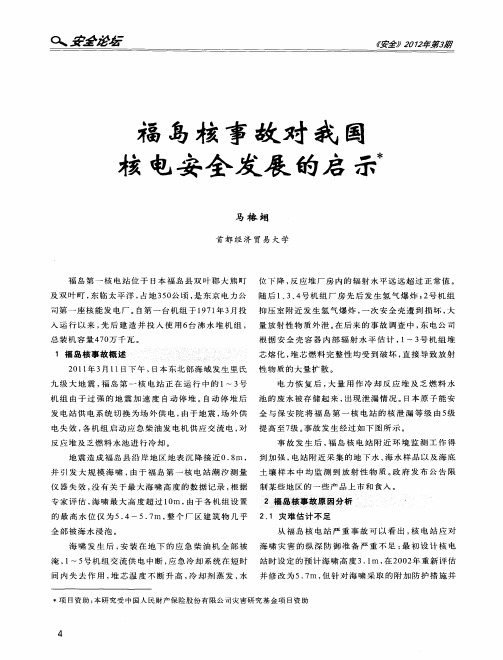
电失效 , 机组 启动 应 急柴 油 发 电机 供应 交 流 电 , 各 对 提 高 至 7 。 故 发 生 经 过 如 下 图 所 示 。 级 事
反 应堆 及 乏燃 料 水池 进 行冷 却 。
事 故 发 生 后 , 岛 核 电 站 附 近 环 境 监 测 工 作 得 福
电 海 地 震 造 成 福 岛 县 沿 岸 地 区 地 表 沉 降 接 近 0. / , 到 加 强 , 站 附 近 采 集 的 地 下 水 、 水 样 品 以 及 海 底 8D _ 并 引 发 大 规 模 海 啸 , 于 福 岛 第 一 核 电 站 潮 汐 测 量 土 壤 样 本 中 均 监 测 到 放 射 性 物 质 。 府 发 布 公 告 限 由 政 仪 器 失 效 , 有 关 于最 大 海 啸高 度 的数 据记 录 , 据 制某 些地 区 的一 些产 品上 市 和 食入 。 没 根 专 家 评 估 , 啸 最 大 高 度 超 过 1 m , 于 各 机 组 设 置 海 O 由
项 目资 助 : 研 究 受 中 国人 民财 产 保 险 股 份 有 限 公 司 灾 害 研 究 基 金 项 目资 助 本
4
致事 件 不断 恶化 。
2 3 纵 深 防 御 失 效 .
为 保 障 核 电 站 安 全 运 行 , 立 多 元 性 、 持 续 性 建 可 以 及 可 各 自独 立 的 防 护 系 统 , 设 备 和 措 施 上 进 行 从
海 啸
多 层 次 的 冗 余 设 计 , 种 纵 深 防 御 的 保 护 策 略 一 直 这
在 核安 全 界受 到推 崇 , 保 核 电站 以及 公众 的安全 。 确 日本 核 电 站 的 安 全 系 统 设 计 一 直 处 于 世 界 领 先 地 位 , 个 机 组 均 安 装 应 急 柴 油 发 电 机 , 配 有 反 应 每 并
福岛核事故对核电安全设计的启示
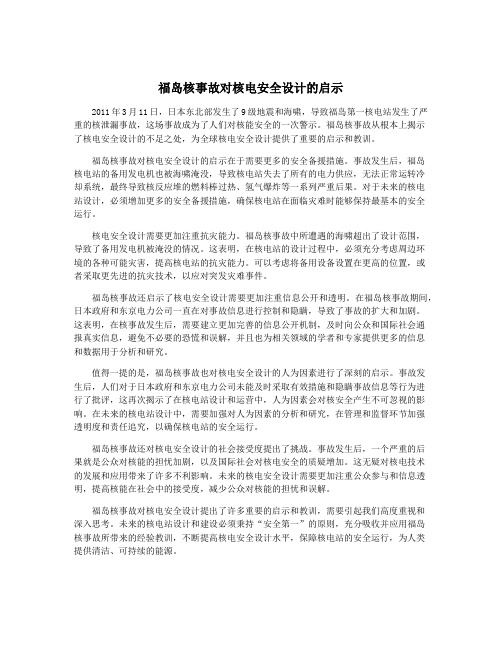
福岛核事故对核电安全设计的启示2011年3月11日,日本东北部发生了9级地震和海啸,导致福岛第一核电站发生了严重的核泄漏事故,这场事故成为了人们对核能安全的一次警示。
福岛核事故从根本上揭示了核电安全设计的不足之处,为全球核电安全设计提供了重要的启示和教训。
福岛核事故对核电安全设计的启示在于需要更多的安全备援措施。
事故发生后,福岛核电站的备用发电机也被海啸淹没,导致核电站失去了所有的电力供应,无法正常运转冷却系统,最终导致核反应堆的燃料棒过热、氢气爆炸等一系列严重后果。
对于未来的核电站设计,必须增加更多的安全备援措施,确保核电站在面临灾难时能够保持最基本的安全运行。
核电安全设计需要更加注重抗灾能力。
福岛核事故中所遭遇的海啸超出了设计范围,导致了备用发电机被淹没的情况。
这表明,在核电站的设计过程中,必须充分考虑周边环境的各种可能灾害,提高核电站的抗灾能力。
可以考虑将备用设备设置在更高的位置,或者采取更先进的抗灾技术,以应对突发灾难事件。
福岛核事故还启示了核电安全设计需要更加注重信息公开和透明。
在福岛核事故期间,日本政府和东京电力公司一直在对事故信息进行控制和隐瞒,导致了事故的扩大和加剧。
这表明,在核事故发生后,需要建立更加完善的信息公开机制,及时向公众和国际社会通报真实信息,避免不必要的恐慌和误解,并且也为相关领域的学者和专家提供更多的信息和数据用于分析和研究。
值得一提的是,福岛核事故也对核电安全设计的人为因素进行了深刻的启示。
事故发生后,人们对于日本政府和东京电力公司未能及时采取有效措施和隐瞒事故信息等行为进行了批评,这再次揭示了在核电站设计和运营中,人为因素会对核安全产生不可忽视的影响。
在未来的核电站设计中,需要加强对人为因素的分析和研究,在管理和监督环节加强透明度和责任追究,以确保核电站的安全运行。
福岛核事故还对核电安全设计的社会接受度提出了挑战。
事故发生后,一个严重的后果就是公众对核能的担忧加剧,以及国际社会对核电安全的质疑增加。
从日本福岛核事故影响看中国的核安全

从日本福岛核事故影响看中国的核安全2011年3月11日14时46分(当地时间),日本宫城县以东约130公里的太平洋海域发生里氏9.0级强烈地震,并引发特大海啸。
日本岩手、宫城、福岛等县沿海地区受到14米高海浪袭击。
位于地震、海浪袭击区域的福岛第一核电站受到了巨大破坏。
特大地震、特大海啸、电力中断等因素加在一起,酿成了这场最高级别的核事故。
福岛第一核电站共有6台核电机组:1、2、3号机组地震发生时正在运行,虽及时插入控制棒使核反应停止,但因外部电网、自备发电机被破坏,无法启动冷却泵,无法降低反应堆温度,导致三台核电机组反应堆建筑物爆炸,有大量放射性物质释放到环境中;4、5、6号机组地震发生时正在停堆检修,但反应堆内和乏燃料池内的乏燃料棒也必须要持续冷却,没有电力则无法做到。
在紧急情况下,采用直升机洒水、高压水车压水、临时电泵注水等多种办法降温,乏燃料池的水温才降下来。
但由于地震和海啸,使核反应堆的地基出现裂缝,大量高放射性废水渗入地下和流入大海,造成了土壤和海水放射性污染。
截止到2011年底,福岛核电站事故的事故后处理工作尚未结束。
这次日本福岛核电站事故被国际原子能机构(IAEA)认定为7级,属于最严重的核事故。
重大核电站事故会向环境中释放大量放射性物质。
这些放射性物质通过吸入、食入进入人体后,会使癌症发病率增加。
所以从原则上讲,人类应该避免一切不必要的照射。
这就是福岛核事故引起各国广泛关注的原因。
在事故早期,人们最关心的放射性核素是碘-131,半衰期较短,仅为8天。
碘-131被摄入人体后主要集中在甲状腺部位,使甲状腺局部受照剂量过大,引发生甲状腺肿、甲状腺结节、甲状腺癌等多种疾病。
根据日本方面公布的数据,福岛核电站事故向环境中释放的碘-131量约为(3.7~6.3)×1017Bq。
人们最关心的另一种放射性核素是铯-137,半衰期30年,被人体摄入后主要集中在肌肉、骨骼等部位。
因为半衰期较长,其危害要比碘-131高40倍。
核电安全事故反思
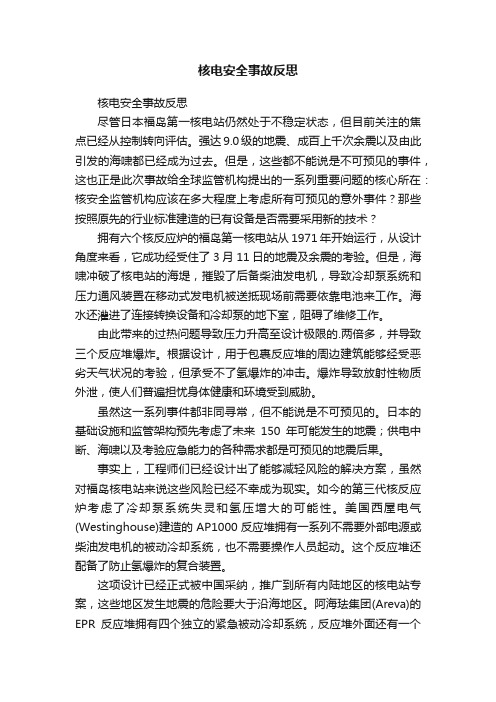
核电安全事故反思核电安全事故反思尽管日本福岛第一核电站仍然处于不稳定状态,但目前关注的焦点已经从控制转向评估。
强达9.0级的地震、成百上千次余震以及由此引发的海啸都已经成为过去。
但是,这些都不能说是不可预见的事件,这也正是此次事故给全球监管机构提出的一系列重要问题的核心所在:核安全监管机构应该在多大程度上考虑所有可预见的意外事件?那些按照原先的行业标准建造的已有设备是否需要采用新的技术?拥有六个核反应炉的福岛第一核电站从1971年开始运行,从设计角度来看,它成功经受住了3月11日的地震及余震的考验。
但是,海啸冲破了核电站的海堤,摧毁了后备柴油发电机,导致冷却泵系统和压力通风装置在移动式发电机被送抵现场前需要依靠电池来工作。
海水还灌进了连接转换设备和冷却泵的地下室,阻碍了维修工作。
由此带来的过热问题导致压力升高至设计极限的.两倍多,并导致三个反应堆爆炸。
根据设计,用于包裹反应堆的周边建筑能够经受恶劣天气状况的考验,但承受不了氢爆炸的冲击。
爆炸导致放射性物质外泄,使人们普遍担忧身体健康和环境受到威胁。
虽然这一系列事件都非同寻常,但不能说是不可预见的。
日本的基础设施和监管架构预先考虑了未来150年可能发生的地震;供电中断、海啸以及考验应急能力的各种需求都是可预见的地震后果。
事实上,工程师们已经设计出了能够减轻风险的解决方案,虽然对福岛核电站来说这些风险已经不幸成为现实。
如今的第三代核反应炉考虑了冷却泵系统失灵和氢压增大的可能性。
美国西屋电气(Westinghouse)建造的AP1000反应堆拥有一系列不需要外部电源或柴油发电机的被动冷却系统,也不需要操作人员起动。
这个反应堆还配备了防止氢爆炸的复合装置。
这项设计已经正式被中国采纳,推广到所有内陆地区的核电站专案,这些地区发生地震的危险要大于沿海地区。
阿海珐集团(Areva)的EPR反应堆拥有四个独立的紧急被动冷却系统,反应堆外面还有一个额外的核心包围区,目前正在芬兰、法国和中国建造。
安全生产征文:日本福岛核电站事故带给我们的反思
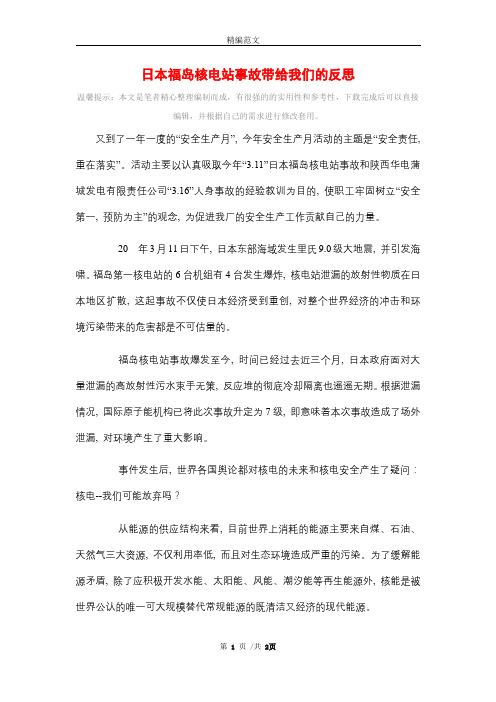
日本福岛核电站事故带给我们的反思温馨提示:本文是笔者精心整理编制而成,有很强的的实用性和参考性,下载完成后可以直接编辑,并根据自己的需求进行修改套用。
又到了一年一度的“安全生产月”, 今年安全生产月活动的主题是“安全责任, 重在落实”。
活动主要以认真吸取今年“3.11”日本福岛核电站事故和陕西华电蒲城发电有限责任公司“3.16”人身事故的经验教训为目的, 使职工牢固树立“安全第一, 预防为主”的观念, 为促进我厂的安全生产工作贡献自己的力量。
20__年3月11日下午, 日本东部海域发生里氏9.0级大地震, 并引发海啸。
福岛第一核电站的6台机组有4台发生爆炸, 核电站泄漏的放射性物质在日本地区扩散, 这起事故不仅使日本经济受到重创, 对整个世界经济的冲击和环境污染带来的危害都是不可估量的。
福岛核电站事故爆发至今, 时间已经过去近三个月, 日本政府面对大量泄漏的高放射性污水束手无策, 反应堆的彻底冷却隔离也遥遥无期。
根据泄漏情况, 国际原子能机构已将此次事故升定为7级, 即意味着本次事故造成了场外泄漏, 对环境产生了重大影响。
事件发生后, 世界各国舆论都对核电的未来和核电安全产生了疑问:核电--我们可能放弃吗?从能源的供应结构来看, 目前世界上消耗的能源主要来自煤、石油、天然气三大资源, 不仅利用率低, 而且对生态环境造成严重的污染。
为了缓解能源矛盾, 除了应积极开发水能、太阳能、风能、潮汐能等再生能源外, 核能是被世界公认的唯一可大规模替代常规能源的既清洁又经济的现代能源。
我国目前核电占所有电力装机的比例不足2%, 不仅远远低于其他主要发达国家的水平, 就连处于同一起跑线的印度和巴西的核电比例都比我们高, 因此对于中国来说, 核电发展的空间非常大。
不过即使核电优势如此明显, 但是其唯一的劣势却是致命的。
此次福岛核电站泄露事件的快速传播, 更是加深了民众对于核电的恐惧, 其实福岛事件有其偶然性和必然性:其一, 天灾罕见, 9级大地震, 20米高的海啸, 有史以来的案例屈指可数;其二, 设备陈旧, 福岛第一核电站的6台反应堆都是最老的二代堆型, 设计比较落后, 遇到自然灾害的抵御能力比较弱;其三, 用工不规范, 福岛第一核电站的工作人员有许多是缺乏必要培训和足够防护措施的临时工;最后, 人祸是关键, 东京电力作为亚洲最大的电力公司, 在核电安全方面所做的努力非常有限, 福岛一号核电站各机组的关键部件十_大保证。
福岛核事故对核电安全设计的启示
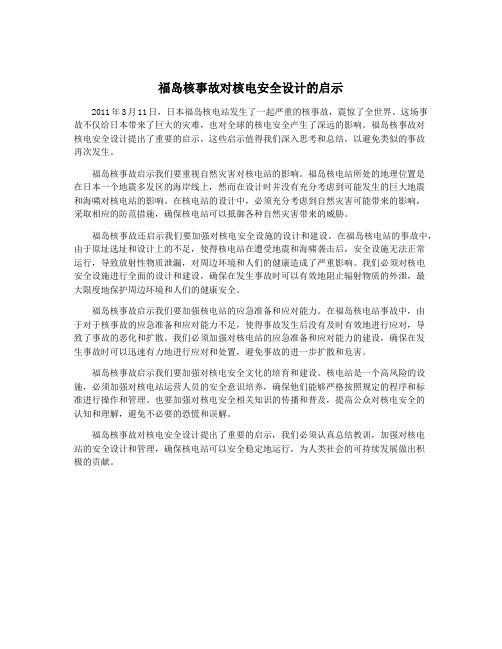
福岛核事故对核电安全设计的启示2011年3月11日,日本福岛核电站发生了一起严重的核事故,震惊了全世界。
这场事故不仅给日本带来了巨大的灾难,也对全球的核电安全产生了深远的影响。
福岛核事故对核电安全设计提出了重要的启示,这些启示值得我们深入思考和总结,以避免类似的事故再次发生。
福岛核事故启示我们要重视自然灾害对核电站的影响。
福岛核电站所处的地理位置是在日本一个地震多发区的海岸线上,然而在设计时并没有充分考虑到可能发生的巨大地震和海啸对核电站的影响。
在核电站的设计中,必须充分考虑到自然灾害可能带来的影响,采取相应的防范措施,确保核电站可以抵御各种自然灾害带来的威胁。
福岛核事故还启示我们要加强对核电安全设施的设计和建设。
在福岛核电站的事故中,由于原址选址和设计上的不足,使得核电站在遭受地震和海啸袭击后,安全设施无法正常运行,导致放射性物质泄漏,对周边环境和人们的健康造成了严重影响。
我们必须对核电安全设施进行全面的设计和建设,确保在发生事故时可以有效地阻止辐射物质的外泄,最大限度地保护周边环境和人们的健康安全。
福岛核事故启示我们要加强核电站的应急准备和应对能力。
在福岛核电站事故中,由于对于核事故的应急准备和应对能力不足,使得事故发生后没有及时有效地进行应对,导致了事故的恶化和扩散。
我们必须加强对核电站的应急准备和应对能力的建设,确保在发生事故时可以迅速有力地进行应对和处置,避免事故的进一步扩散和危害。
福岛核事故启示我们要加强对核电安全文化的培育和建设。
核电站是一个高风险的设施,必须加强对核电站运营人员的安全意识培养,确保他们能够严格按照规定的程序和标准进行操作和管理。
也要加强对核电安全相关知识的传播和普及,提高公众对核电安全的认知和理解,避免不必要的恐慌和误解。
福岛核事故对核电安全设计提出了重要的启示,我们必须认真总结教训,加强对核电站的安全设计和管理,确保核电站可以安全稳定地运行,为人类社会的可持续发展做出积极的贡献。
日本核电站事故后的安全措施改进

日本核电站事故后的安全措施改进在2011年3月的福岛核电站事故之后,全世界对于核能安全问题产生了更为严肃的关注。
这一事故给日本乃至全球的核能行业带来了深刻的教训,促使各国加强了核电站的安全措施。
本文将介绍日本核电站事故后的安全措施改进,并探讨这些改进对全球核能产业的影响。
一、加强设备安全性能事故发生后,日本核能监管机构对核电站的设备安全性能进行了重新评估,并提出了更为严格的标准。
为了确保设备在异常情况下的安全性能,核电站进行了设备升级和更换,采用了更为先进的技术和装备,以应对可能发生的事故。
二、改进应急预案福岛核电站事故中,事故后的应急处置措施不够及时有效,导致放射性物质泄漏,对周边环境和人民的健康造成了严重影响。
为了避免类似情况再次发生,日本核能监管机构对核电站的应急预案进行了全面修订。
新的应急预案要求核电站能够迅速、及时地采取措施,以最大限度地减少事故对环境和人民的影响。
三、建立独立监管机构福岛核电站事故揭示了日本核能监管机构的不足之处,监管不到位和监管权力分散是导致事故发生的重要原因之一。
为了改进核能监管体系,日本成立了独立的核能监管机构,对核电站的安全运行进行全面监管和评估,确保其符合严格的安全标准。
四、提高人员培训和意识在核电站的安全运行中,人员的技术水平和安全意识起着至关重要的作用。
为了提高人员的技能和安全意识,日本核电站事故后,加强了对核电站人员的培训和考核。
核能运营企业要求员工接受更为系统、专业的培训,确保他们具备应对突发情况的能力和知识。
五、加强国际合作和信息共享福岛核电站事故的影响不仅局限于日本本国,还对全球核能行业产生了重要影响。
为了提高全球核能安全水平,各国加强了合作与交流。
通过国际组织和论坛,各国分享核能安全方面的经验和技术,共同应对核能安全挑战,降低核电站事故的风险。
总结起来,福岛核电站事故对于日本和全球核能行业来说,都是一个重大的警示。
事故后,日本核能监管机构采取了一系列改革措施,加强了核电站的安全措施和防范措施,提高了设备的安全性能,改进了应急预案,建立了独立监管机构,并加强了对核能人员培训和意识的要求。
日本核事故再次引发欧洲思考核能安全
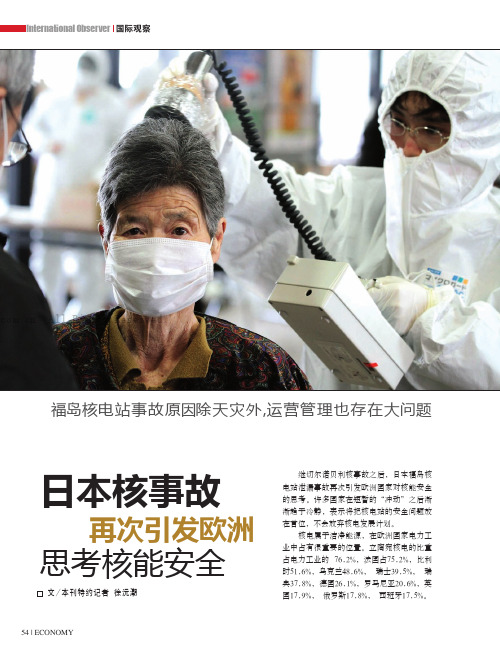
54 | ECONOMYInternational Observer 国际观察继切尔诺贝利核事故之后,日本福岛核电站泄漏事故再次引发欧洲国家对核能安全的思考。
许多国家在短暂的“冲动”之后渐渐趋于冷静,表示将把核电站的安全问题放在首位,不会放弃核电发展计划。
核电属于洁净能源,在欧洲国家电力工业中占有很重要的位置。
立陶宛核电的比重占电力工业的 76.2%,法国占75.2%,比利时51.6%,乌克兰48.6%, 瑞士39.5%, 瑞典37.8%,德国26.1%,罗马尼亚20.6%,英国17.9%, 俄罗斯17.8%, 西班牙17.5%。
日本核事故再次引发欧洲思考核能安全福岛核电站事故原因除天灾外,运营管理也存在大问题文/本刊特约记者 徐沅潮. All Rights Reserved.福岛核事故发生后,欧盟于3月15日在布鲁塞尔就核能安全召开紧急会议,讨论并决定对欧盟境内及邻国的核电站进行压力测试,以检验这些核电站在遭遇地震、洪水、海啸、恐怖袭击或者供电故障的紧急情况下,是否还能够应对。
欧盟希望欧洲核电站能切实执行统一的安全标准,同时还要求欧洲各国做好紧急预案,确保居民在紧急状态下的逃生路线。
欧盟负责能源事务的委员奥廷格认为,欧盟必须从日本核事故中吸取教训。
不过,他也表示,没有必要就此把核能一棍子打死,该发展的还是要发展,只是要尽最大努力保证核能的安全使用,如有必要欧盟将采取预防性措施。
德国总理默克尔要求法国总统萨科奇将国际核能标准的讨论列入11月G20峰会议程。
法国是世界最大的核能生产国,现有核电能力占全国总电力的75.2%,因此法国的立场对欧盟来说至关重要。
法国总理府发表的声明称,法国多年来致力于发展核能,一直将“安全至上”作为核电站建设的工作重点。
法国将对日本发生的事故认真吸取有用的教训。
德国总理默克尔说,德国不能无视日本的核危机,那些原来认为不可能发生的风险,结果却变成了现实,所以德国将对所有核电厂进行检验。
日本福岛核电站发生爆炸的教训
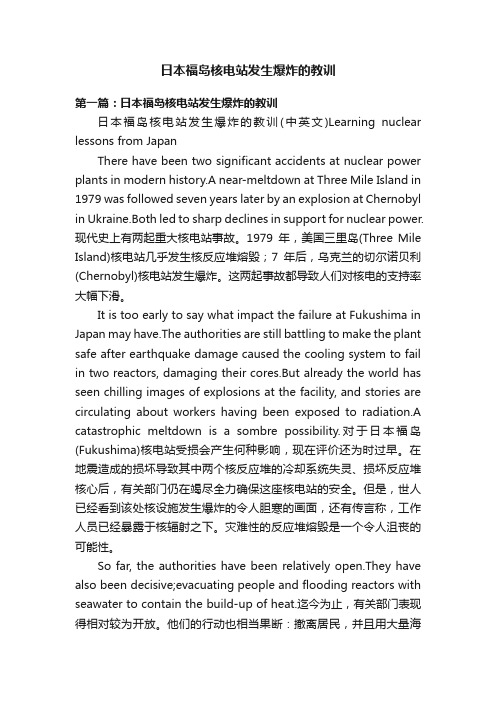
日本福岛核电站发生爆炸的教训第一篇:日本福岛核电站发生爆炸的教训日本福岛核电站发生爆炸的教训(中英文)Learning nuclear lessons from JapanThere have been two significant accidents at nuclear power plants in modern history.A near-meltdown at Three Mile Island in 1979 was followed seven years later by an explosion at Chernobyl in Ukraine.Both led to sharp declines in support for nuclear power.现代史上有两起重大核电站事故。
1979年,美国三里岛(Three Mile Island)核电站几乎发生核反应堆熔毁;7年后,乌克兰的切尔诺贝利(Chernobyl)核电站发生爆炸。
这两起事故都导致人们对核电的支持率大幅下滑。
It is too early to say what impact the failure at Fukushima in Japan may have.The authorities are still battling to make the plant safe after earthquake damage caused the cooling system to fail in two reactors, damaging their cores.But already the world has seen chilling images of explosions at the facility, and stories are circulating about workers having been exposed to radiation.A catastrophic meltdown is a sombre possibility.对于日本福岛(Fukushima)核电站受损会产生何种影响,现在评价还为时过早。
核事故对核安全的启示

核事故对核安全的启示SatetylessonsfromNuclearAccidents在核能民用的历史上,发生了两起重大的反应堆事故:前苏联的切尔诺贝利核电站事故和美国的三里岛核电站事故,这是商用核电厂在32个国家中累积运行12000堆年期间仅有的两起重大事故。
切尔诺贝利核事故由于没有装备安全壳而造成重大损失,相比,安装有安全壳的三里岛核事故却没有对任何人造成放射性伤害。
反思这两个事故的不同后果,使我们加深对核安全的认识具有积极的意义。
按照事故或恐怖袭击的可能性和结果,核电站的风险与其他产业普通公认的风险相比是最小的。
首先,核电站是非常强韧坚固的,其中安全措施的目标是保证在所有合理的可能想象的情况下,放射性辐照绝对不会危及公众健康和安全。
以美国的三里岛核事故为例,虽然该反应堆受到了严重的损坏,但是放射性物质被包容限制在安全壳内,没有对人员健康和环境造成不利的结果。
1957年,联合国设立了国际原子能机构。
作为世界核安全的审计者,国际原子能机构起草规定了核安全程序和报告核事件。
在20世纪90年代,这种作用得到了明显增强。
现在,每一个运行着核电站的国家都要有核安全监事会,所有的核安全监事会都与国际原子能机构密切合作。
一个强制性的安全指标可以最大限度地减少反应堆事故发生的可能性,就是通过计算得出的反应堆堆芯损坏或熔化事故的发生频率。
美国核管会详细规定,反应堆设计必须满足堆芯损坏事故发生频率小于万分之一。
不过,现在的设计已经胜过了这个限值。
当前运行中的最好的核电站的堆芯损坏事故发生频率大约是百万分之一,而在下一个十年可能建造的新的核电站,其堆芯损坏事故发生频率将几乎是千万分之一。
美国三里岛核事故是在符合安全标准的反应堆中惟一的事故,由于设计特性使事故影响受到限制,因而没有对任何人造成放射性伤害。
按照目前的核电站监管标准要求,堆芯熔化事故的影响必须限制在厂内,不需要疏散撤离附近的居民。
对核安全主要的关注点一直是放射性物质不可控制释放的可能性,它导致环境污染和厂外放射性辐射后果。
Fukishima 关于福岛核泄漏事件的讨论 英文版
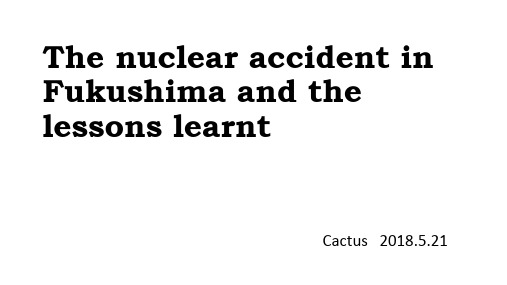
Cactus 2018.5.21
I. Why did we chose this topic
Nuclear Power Plants in China:
(2018.3) 38 nuclear reactors 18 under construction an alternative to coal fastest-growing electricity source Ranks 3rd by power generated
2018.2.2
Standard:Cs<100Bq/kg,I<500Bq/kg
How long will it last ?
The
half-life of radioactive elements: (I)131:8 days (Cs)137:30 years ……
Nuvacuation
3.Prevent nuclear proliferation
shield the accident scene send experts to help stop the leakage restrict contaminated food and water
radioactive substance
polluted ocean
Ocean
currents
Diseases
Irradiation
disease
Induce cancer,gene mutation and chromosome aberration
Bq
2011.4.1
- 1、下载文档前请自行甄别文档内容的完整性,平台不提供额外的编辑、内容补充、找答案等附加服务。
- 2、"仅部分预览"的文档,不可在线预览部分如存在完整性等问题,可反馈申请退款(可完整预览的文档不适用该条件!)。
- 3、如文档侵犯您的权益,请联系客服反馈,我们会尽快为您处理(人工客服工作时间:9:00-18:30)。
Nuclear Safety After FukushimaEven with events at Japan's Fukushima Daiichi nuclear power complex still in a state of flux, attention is shifting from containment to assessment. The 9.0 magnitude earthquake, hundreds of aftershocks and ensuing tsunami were historic. But they can hardly be calledunforeseeable, and therein lies the nub of the critical questions this incident will raise for regulators everywhere: To what extent should nuclear safety regulation take account of all foreseeable contingencies, and should new technologies be required to apply to pre-existing facilities that were built to the standard of the industry at the time of construction?The six-reactor Fukushima Daiichi facility was commissioned in 1971 and—by design—successfully withstood the March 11 earthquake and its aftershocks. But the tsunami topped the facility's sea wall, knocking out the back-up diesel generator and forcing the pump cooling systems and pressure ventilators to rely on batteries until mobile generators could be delivered to the site. Water also flooded the basement where switching equipment connected the pumping equipment, impeding repairs.The result was overheating that caused pressure to build to over two times the designed limitations and led to explosions at three of the reactors. The outer buildings were designed to contain the reactor andto withstand severe weather conditions, but not hydrogen explosions. Radiation leakages resulted, causing widespread concerns about threats to health and the environment.Such a chain of events, however extraordinary, cannot be said to be unforeseeable. Japan's infrastructure and regulatory framework have anticipated earthquakes for 150 years; power outages, tsunamis and widespread demands that strain response efforts are all predictable consequences of earthquake risk.Indeed, engineers have already designed solutions to mitigate the risks that materialized at Fukushima. Today's third-generation nuclear reactors anticipate the possibility of failed cooling systems and hydrogen pressure build-ups. The Westinghouse AP1000 reactor has a series of passive cooling systems that operate without external ordiesel-generated power or activation by its operators. It also has recombiners that prevent hydrogen explosions.This design has been officially adopted in China for all inland nuclear projects where earthquake risks are more prevalent than on its coasts. Areva's EPR reactor under construction in Finland, France and China has four independent emergency passive cooling systems and extra core containment areas around the reactor. And Mitsubishi's new APWR has passive and active redundant cooling systems.So why weren't these technologies installed at Fukushima? Nuclear safety regulators around the world assess risks associated with nuclear power facilities on the basis of the technology to be deployed and the location and range of events that potentially could threaten the safety or control of the facility. Even after construction, regulators are given wide discretion to impose additional requirements on the equipment, systems and procedures used at a given facility.The problem is how to decide when to require plant operators to implement costly refits of new technology on older plants—and this is where Japan's regulators could ultimately come in for some justifiable scrutiny. This is a question of both engineering and cost-benefit analysis. While certain modular equipment and control systems in nuclear plants can be upgraded, integral parts of the reactor chamber or housing cannot be easily removed, disposed of and replaced due to the presence of radioactivity.This means that in some cases the choice may not be whether or not to upgrade, but whether to shut down entirely. Given those options, operators and regulators are inclined to maintain the status quo instead of requiring the application to old facilities of newer systems to more effectively address risks that can seem quite remote. Fukushima may cause a rethink of this approach not only in Japan but around the world.Japan's experience also suggests regulators and emergency planners need to think more realistically about the circumstances under which an emergency is likely to occur. Most nuclear safety regulations are based on a scenario where a singular disaster occurs at a specific facility—akin to Chernobyl or Three Mile Island, incidents that arose due to circumstances within the plants themselves or external events affecting their immediate vicinity.That approach to planning can leave officials unprepared for what has happened at Fukushima: a nuclear incident as part of a much larger disaster. In the aftermath of the Sendai earthquake, response teams and resources were required to cover an area of 35,000 square miles, in which two million people were without power, water or food, and roads, airports and other infrastructure were severely damaged. Morefar-sighted planning would have anticipated the limitations on emergency services in such circumstances.Finally, regulators need to account for the societies and particular cultures they cover. Japan's great wealth, technological advancement and quality infrastructure made it remarkably resistant to the ravages of a great earthquake and horrific tsunami. And the high levels of education and the renowned discipline of its people certainly helped it avoid apocalyptic consequences. While this hasn't averted the problem atFukushima, it does mean the country was better equipped to deal with such an event than others might have been.Regulators in Vietnam, Malaysia, Thailand, the Philippines, Indonesia and other developing nuclear aspirants that ring the fault lines of much of the Pacific Ocean need to candidly assess their nation's capacity to respond in similar circumstances. Would they have the resources to deal with a Fukushima-style incident, even apart from any question about the quality of pre-disaster planning?At some point in the future even the most modern nuclear power systems on today's drawing boards will appear antiquated compared to the day's technology. Fukushima should give regulators both today and tomorrow pause in how they approach the issue of safety in the face of technological evolution.(Mr. Stephens is a Hong Kong-based senior partner with the law firm Orrick, Herrington and Sutcliffe. )福岛核事故之后的核安全反思尽管日本福岛第一核电站仍然处于不稳定状态,但目前关注的焦点已经从控制转向评估。
